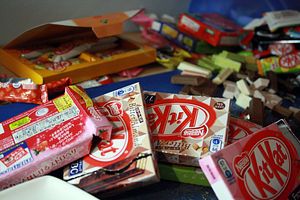When Western brands open shop in East Asia, they often have to readjust several elements of their business models and products to appeal to diverse tastes. In the case of the food and beverage industry, the translated names of companies can have a large impact on the desirability of a consumable product.
The development and success of Kit Kats in Japan is a prime example of a company’s successful adaptation to a new audience. The chocolate wafer company first appeared in Japan through parent company Nestlé in 1973. In 2000, Nestlé Japan released its first non-chocolate flavor: strawberry. Since then, Kit Kat has created over 350 varieties and embedded itself in Japanese culture. While the imaginative recreation of typically Japanese flavors such as Matcha Green Tea and red bean contributed to its rise, Kit Kat also relied on the unique branding opportunity presented by the Japanese language.
The brand name “Kit Kat” was transliterated into “Kitto katto” (キットカット) in Japanese, which phonetically mirrors the phrase “kitto katsu” (きっと勝つ). “Kitto katsu” can translate into several positive phrases, ranging from “surely going to win” to “never fail.” As a result, Kit Kat began marketing itself as a good luck charm in all areas of Japanese society. Kit Kats have become particularly popular gifts around exam periods for students and now come packaged with specific encouraging phrases like “do your best” and “believe in yourself.” Cédric Lacroix, who manages Nestlé in Japan and Korea, has stated the Japanese consume nearly 5 million Kit Kat bars daily.
Nestlé even ventured to cover Kit Kats in real gold in 2015 and scatter them throughout Japanese stores, evoking a Charlie and the Chocolate Factory gold hunt for a luxury confectionary item. One bar was worth 2,016 yen ($16 at the time). These gold bars also migrated to Australia. The popularity of Kit Kat in Japan has spread around the world, resulting in an in-depth report on how Kit Kats are made in Japan by the New York Times in 2018 and tourists flocking to specific Kit Kat chocolatories throughout Japan.
Kit Kat’s popularity in Japan thanks to word play is not unparalleled. When Coca-Cola first appeared in China in 1927, the company’s name was transliterated into Chinese characters rather than renamed completely. The first iterations of those translations resulted in company names like “female horse fastened with wax” and “bite the wax tadpole.” In 1928, Coca-Cola changed its name to be both a close transliteration and more accurate representation of the message of the brand. Coca-Cola, or “Ke kou ke le” (可口可乐) in Mandarin, now translates to “permit mouth to be able to rejoice” or “delicious happiness.”
Beyond Coca-Cola, Pepsi and Kentucky Fried Chicken (KFC) each had difficulties localizing their brand slogans, resulting in slogans such as “Pepsi brings your ancestors back from the grave” (instead of “Pepsi brings you back to life”) and “eat your fingers off” (instead of “finger licking good”). Transliterated company names abound outside of the food and beverage space as well. One famous failure includes the naming of sports car company Mercedes Benz as “Bensi” in Mandarin, which can translate to “rush to die.” This was later corrected to “Benchi” (奔驰) or “galloping.”
Although poorly translated names may not have a proven impact on business success, Kit Kat and Coca-Cola prove that good transliterations both solidify the impact of cohesive, international branding and can embed products into foreign cultures. Brand names including Kit Kat and Coca-Cola may have chosen their transliterations based on the original pronunciation of their products, but those transliterations have morphed from representative phrases to just simply becoming the brands themselves. For example, “Kitto katsu” (きっと勝つ) now pulls up the Kit Kat website. Similarly, while the characters for “Benchi” still mean “galloping” in Chinese, they also immediately relay to the Mercedes Benz webpage. By adopting the local language of their markets, international companies have co-opted phrases from those markets and reformulated them to their own success.

































